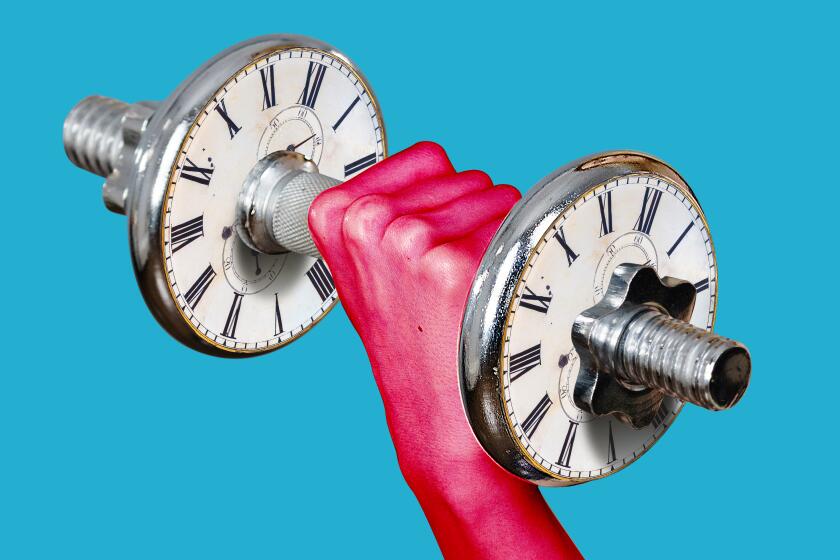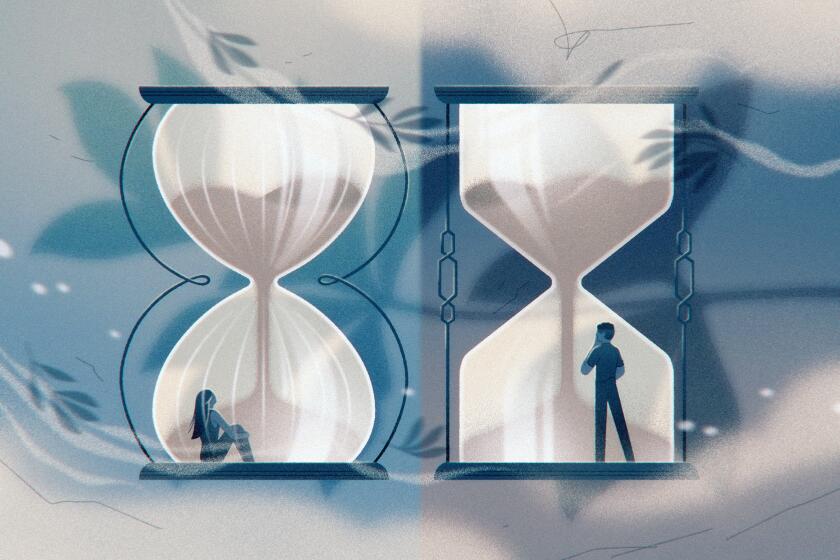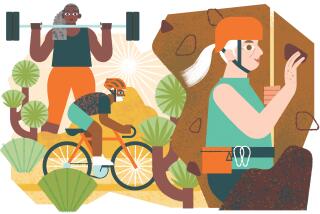
- Share via
- Deathracer413 is a group of vertical skateboarders, mostly in their late 50s and 60s, who believe the sport is their key to longevity.
- It keeps them physically fit, connected to community and the danger, they say, keeps their brains sharp.
- As the first generation of ’70s and ’80s-era skateboarders to age into older adulthood, they’re pushing the limits of the sport.
Chad Rivera gingerly makes his way to the edge of what looks like an emptied out swimming pool, a lime-green skateboard in one hand, a white cane in the other. At 58, he’s legally blind, but he’s been skateboarding since he was 5, so what’s about to happen is part muscle memory, part “trust fall.”

Dozens of other skateboarders — mostly men in their 50s and 60s decked out in skating gear — roll along the periphery, watching on, at Encinitas Skate Park near San Diego. It’s not yet 11 a.m., but punk music blasts from the speakers, punctuated by the rumbling and clanking of skateboard wheels on concrete.
Standing at the deep end, Rivera considers the pool bowl’s nine-foot concrete walls. He sets down his white cane and secures the tail of his board on the pool’s rim with one foot, the rest of the board hanging in the air, like a mini diving board. He then steps onto the front of the board with his other foot and throws his body weight forward, “dropping in.”
He races down and around the sides of the walls before flipping around and landing back up on the pool deck.
It’s a frightening move to watch, but Rivera now beams, triumphant, eyes shining.
“Woo! Feel it and kill it,” says Rivera, a retired grape grower who’s suffered from a rare optic nerve disease since he was 22. “It always feels good, so I keep doing it. I’ll never stop, no matter how old I get.”
Rivera is a member of Deathracer413, a group of older skateboarders who believe that skateboarding is their key to longevity. They grew up amid the ’70s and ’80s skate scene and are as passionate about the sport as when they were teens. Many of them are now retired and the joy they get from skateboarding, the sense of community and the health benefits, such as core strength and balance, keep them young, they say. The inherent danger gives them an adrenaline rush that, they argue, keeps their brains sharp.
Strength training has many benefits for health and longevity. Now many older Angelenos are seeking out a method called slow-motion strength training to protect their joints and heal injuries.
“Our slogan is: Keep dropping in or you’ll be dropping out,” says the group’s founder, Doug Marker, a former professional skateboarder and retired construction worker who’s lived in San Diego his entire life. Marker, who also surfs, plays guitar and rides motorcycles, is 63 going on 16, with silver hair and a skate-park suntan. On this Saturday morning, he’s wearing baggy shorts, Vans sneakers and a graphic T-shirt featuring “Death Racer” in heavy metal band-like typography.
“Knowing you can get hurt keeps you ultra-focused,” Marker says. “And trusting that you can do it — believing in yourself — is hugely empowering. I keep dropping in, I keep going. It’s put me into a bubble where I never feel like I’m getting older.”
- Share via
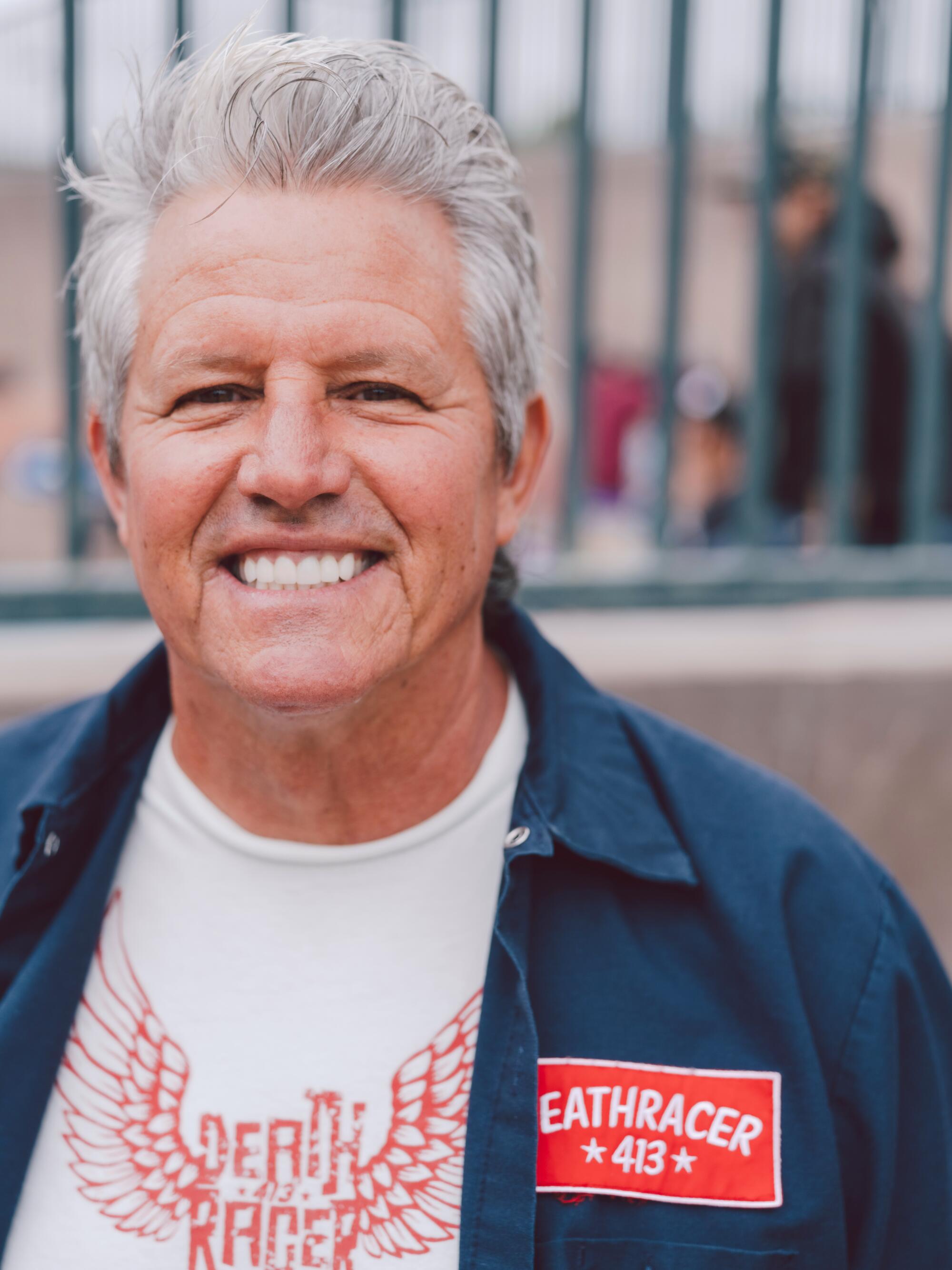
Marker founded Deathracer413 in 2011 to draw like-minded people who are “living life to the fullest,” he says. The name Deathracer reminded him of a motorcycle club and 413 are his initials, numerically. It was just a loose social affiliation at first, but in 2020 Marker launched the Deathracer413 Road Show, an invitation to join him in skating a different skate park every Saturday.
Deathracer413 now includes former and current pro skateboarders doing tricks alongside average enthusiasts and late-life skating newbies. There are a handful of women in the group as well as a few children honing their skills with the masters.
Marker estimates there are about 1,300 members of the group internationally, though typically only about 20-30 locals attend on any given Saturday. He welcomes anyone into the club and mails them a “welcome letter” and custom Deathracer413 patch that he designed. Hundreds of recipients remain members from afar, kindred spirits who share a “full throttle” outlook on life and participate via social media. Others have trekked from Australia, Germany, Belgium and the UK to skate with Deathracer413.
“’Cause now everybody’s retired and can travel,” Marker says. “They’re finding destinations to come and skateboard and San Diego’s a top one. So they come.”
‘I’ll stop when my body tells me to stop’

As Deathracer413 celebrates its 200th skating session, the vibe is affectionate and rambunctious, jovial retiree backyard barbecue meets heavily tattooed skater meetup. More than 50 members — many with bushy gray beards, paunchy bellies and caps reading “The Goonies: Never Say Die” or “Independent” — mingle on the pool deck, cracking open beers, fist-bumping one another and catching up on life as the Ramones’ “I Wanna Be Sedated” fades into Bikini Kill’s “Rebel Girl” on the sound system.
The skaters drop into the pool one after another — swirling and swooshing around, “carving” and “grinding,” before popping back up — in such tight succession it feels choreographed. It’s as if we’re inside a pinball machine, with tiny objects orbiting around one another maniacally, wheels spinning, helmets twisting, boards whizzing by or flying into the air before crashing back down. Every so often someone wipes out, sliding across the pool bottom, sparking cheers of encouragement.
“I feel like the older I get the more I worry about getting hurt — because it lasts longer,” admits skateboarding legend Steve Caballero, 60. “If you think about it, it’s kind of a scary sport. You can get really hurt.”
Mary Serritella started pole dancing at 57. Fourteen years later she’s inspiring others who are decades her junior.
Caballero has been a pro skateboarder since he was 15 and fear doesn’t stop him today — “I’ll stop when my body tells me to stop,” he says. He performs one of his signature moves, sliding along the rim of the pool on the skateboard truck instead of the wheels. No small feat for a body that’s endured more than 45 years of extreme athletics. A documentary about his life, “Steve Caballero: The Legend of the Dragon,” debuts this November.

“It definitely keeps me in shape,” he says. “It keeps me youthful-thinking, staying creative and being challenged. I think when people get older they quit doing these things because they feel like they should. I’m trying to show people, hey, even in your older age you can still have fun and challenge yourself.”
The feeling of freedom, the thrill of sailing through the air, is worth the risk to Barry Blumenthal, 60, a retired stockbroker.
“I’m more worried about crashing my car. I mean, I wear gear in here,” Blumenthal says. “Skating is just extreme fun where you can’t help but grin. It’s kid-like. It’s a fountain of youth experience. You’re chasing stoke.”
Pushing the boundaries of skating
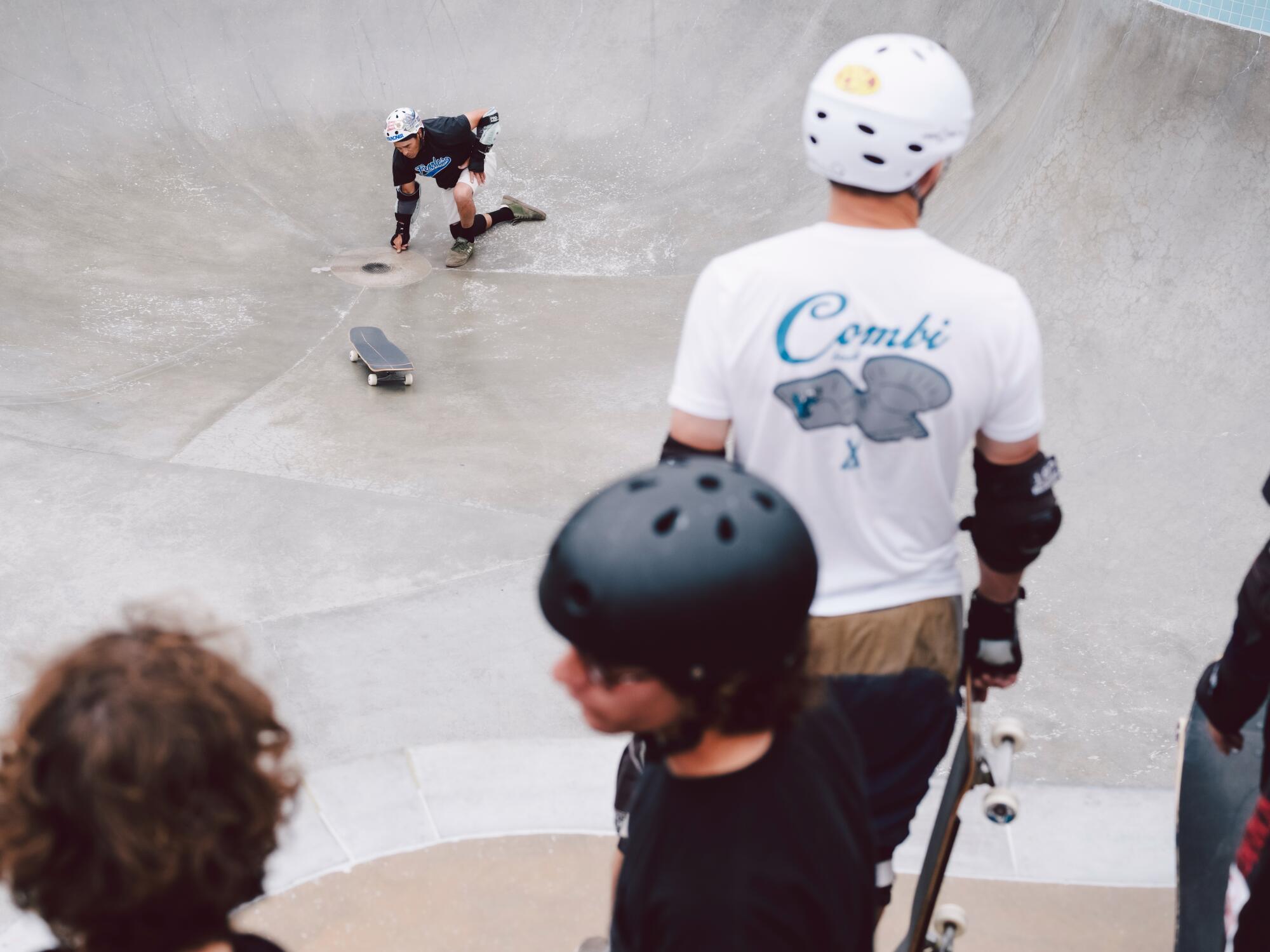
No doubt “dropping in” and “chasing stoke” for eternity would be “rad.” But is there any validity to Deathracer413’s claims that skateboarding promotes health and longevity?
“I’d worry about fractures,” says Dr. Jeremy Swisher, a UCLA sports medicine physician. “As you get older, it takes the body longer to heal. But it comes down to a risk-benefit analysis. The endorphins, the adrenaline — the joy of it — as well as the new challenges that stress the mind in a good way would be very mentally stimulating. You’re forming new neural pathways as you’re trying new moves. It would help keep the brain young and fresh.”
“I race cars for a hobby, and I know what that does for my aging,” adds Dr. Eric Verdin, president and chief executive of the Buck Institute for Research on Aging in Northern California. “Finding a thing that you’re passionate about, having a sense of community, not to mention the balance and motor coordination — skateboarding is extremely physical — all of that is part of healthy aging.”
They say strength training is crucial as you age, but it’s also more difficult. Here are 9 tips for how to do it right.
Deathracer413 also has an important place in the trajectory of skateboarding.
Skateboarding has been around in California since the 1950s — a way to recreate surfing, but on dry land. “Vertical skateboarding,” which the Deathracers partake in, grew out of SoCal kids commandeering emptied backyard swimming pools. It was especially prevalent during the 1976-77 drought, when residents had to drain their pools and kids began performing elaborate airborne tricks. Skate parks emerged and “vert skating,” as it was dubbed, became a phenomenon.
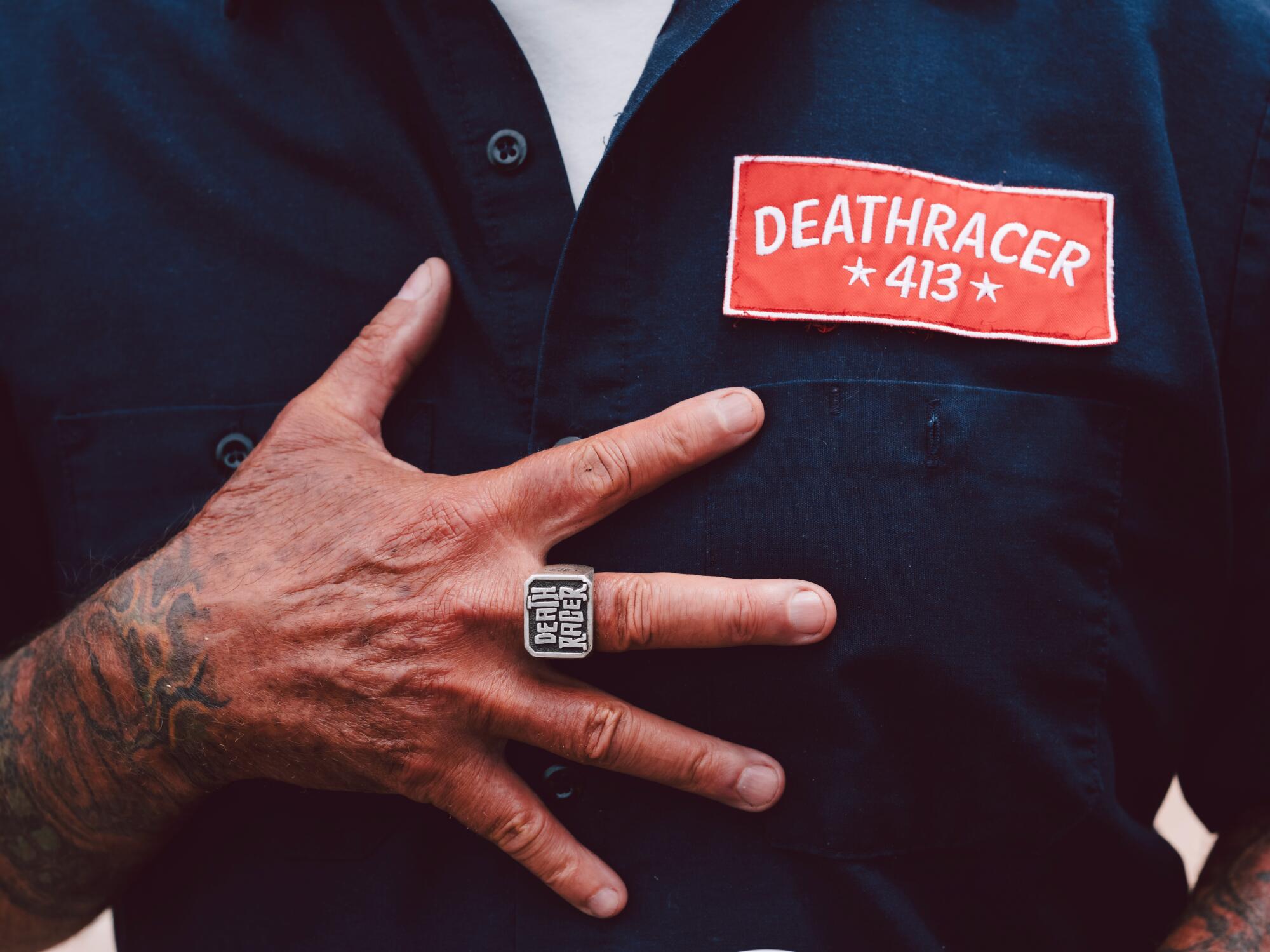
The first park in California opened in Carlsbad in 1976 and the San Diego area is still considered a central hub for the sport. So today there’s a critical mass of ’70s and ’80s-era skateboarding devotees who still live nearby. That’s why Deathracer413 — the only club of its kind in the area, Marker says — has so many active members.
“There hasn’t ever been 60-year-plus [vert skaters] before,” Marker says. “The sport’s not that old. So that’s kind of our thing — we’re just gonna keep pushing the bar.”
In that sense, Deathracer413 is more than a subcultural vestige — its members present a sports medicine study of sorts, says Michael Burnett, editor in chief of “Thrasher Magazine,” a longtime skateboarding publication.
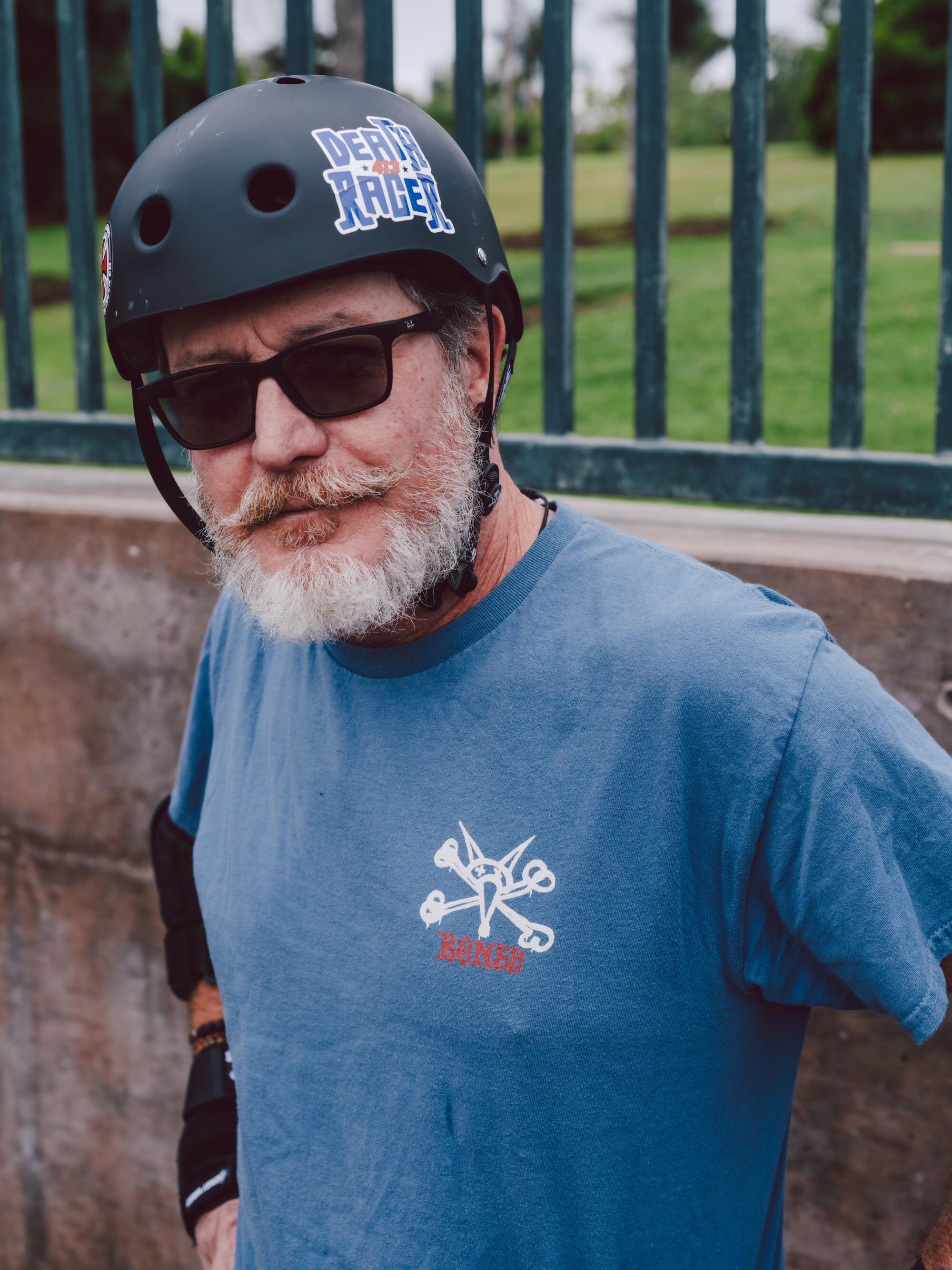
“There were a few old-guy outliers, but this is the first generation of older skaters,” Burnett says. “We’re now witnessing how long someone can physically skateboard for — this is the test. It’s uncharted territory.”
Still, many of the Deathracers have modifed their skating techniques as they’ve aged. Marker says he now skates within 80-85% of his ability range to be safe. Others admit that the inevitable — death — is on their minds.
“As an older adult, you can get into your head about, oh, how much time do I have left?” says John Preston Brooks, 56. “But a lot of people here are older than me and it just makes me realize I got a lot more time to do the things I love and make the best of life.”
David Skinner, 60, a retired school teacher, says he’s realistic about his physical limits.
“A lot of us have health issues,” he says. “We’re not necessarily trying to cheat death, but we’re definitely trying to stay ahead. We know it’s coming, but we wanna keep dropping in and having fun, and this gives us a venue to do it.
A brotherhood, even if you no longer skate
As the day grinds on, the skate session morphs into an actual barbecue. Marker fires up the grill, tossing on an assortment of meat: burgers, bratwursts, hot dogs. Plumes of aromatic smoke float over the pool bowl, which is still getting some action.
Lance Smith, 74, stands off to the side of the bowl, a Coors Light in one hand, a Nikon camera in the other. With his dark sunglasses, soul patch of facial hair above his chin and trucker hat that reads “Old Bro,” he appears like someone’s cool great-uncle. He can’t skate anymore due to three replacements — two hip, one knee — after years of skateboarding injuries. (“I wouldn’t trade it for anything,” he says.) But Smith, who documented the SoCal skateboarding scene in the ’70s and photo edited the book “Tracker: Forty Years of Skateboard History,” still attends Deathracer413 events nearly every Saturday. He photographs club members in action.
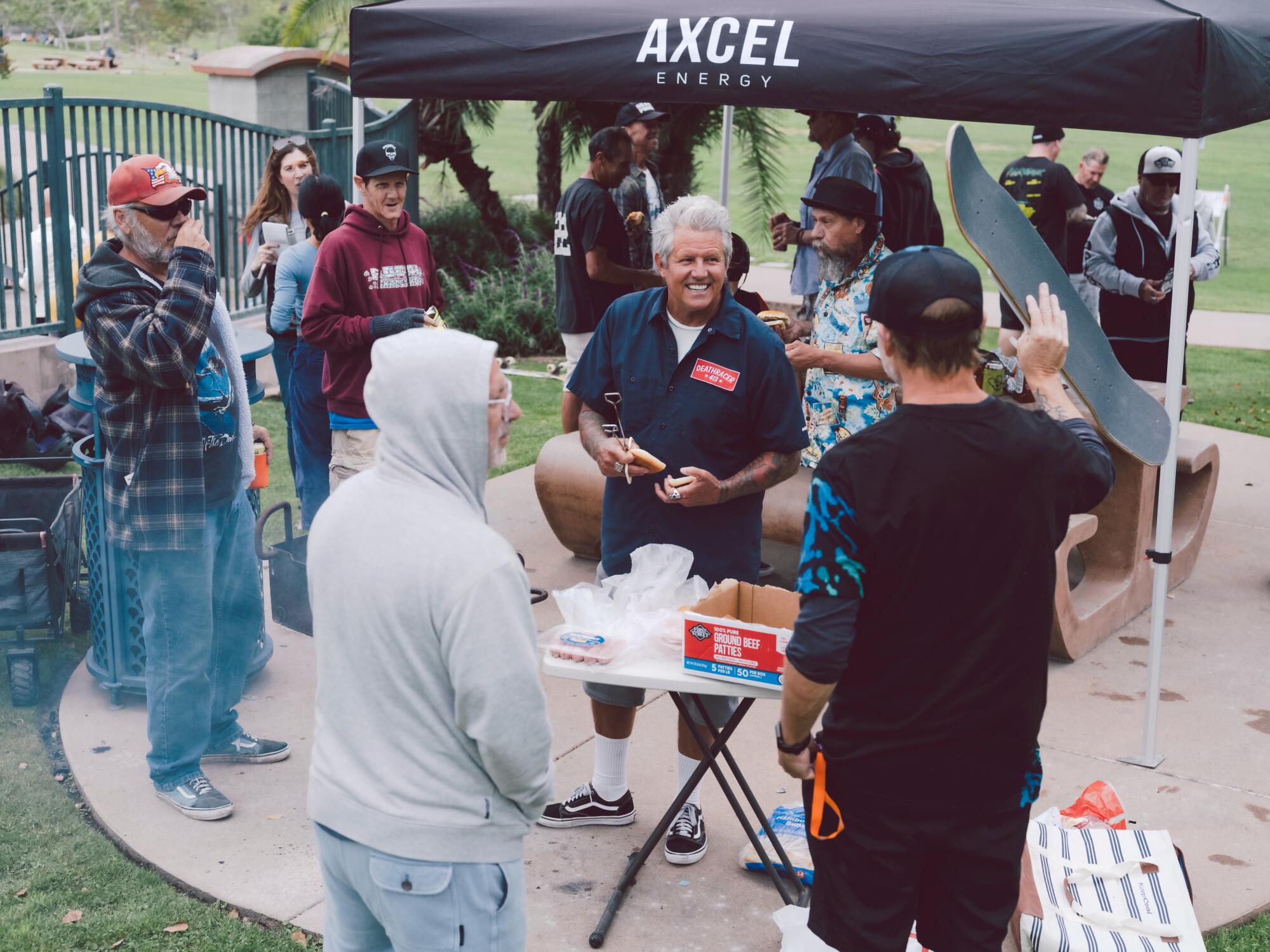
“It’s the community,” Smith says, stretching out his arm and snapping a passing skater. “I get enjoyment out of shooting pictures and seeing my friends skateboard. And, yeah, drinking a Coors Light.”
Deathracer413 is both a brotherhood and a sisterhood, says Tuli Lam, 31, a physical therapy student and one of the only women skaters in attendance today. “When I’m here, I’m just one of the guys. We’re bonded by skating.”
That camaraderie is evident when the group presents Marker with a gift of thanks.
In “Ageless Aging,” social researcher Maddy Dychtwald offers a holistic guide to improving your longevity.
“OK, gather round! Bring it in!” yells Lansing Pope, 58.
The skaters crowd around, stretching their necks to see what’s in the wrapped box Marker is tearing open.
“It’s a knee brace!” someone yells.
“It’s a crutch!” says another.
“Something for his prostate?” jokes a third.
“Whoa, super dope,” Marker says. (It’s a leather Deathracer413 bedroll for his motorcycle.) “I’m super stoked.”

“Till your wheels fall off!” several guys scream in unison, fists in the air.
Then, as if on cue, the skaters disperse around the pool bowl, streaming in and out of it, the sound of rattling wheels and screeching metal on concrete filling the space.
Tye Donnelly, 54, surveys the scene from a nearby picnic table, an electric guitar on his lap. He noodles on it, playing a mix of Black Sabbath and reggae.
“When I was 18, I never thought I’d be the old age of 20 and still skateboarding,” he says. “At 54, I thought I’d have a hat on, a suit, with a newspaper. But it turns out you can skateboard your whole life. And I’m thankful for this group — because it wasn’t like this back in the day.”
Caballero sums up senior skateboarding best: “This is the new bingo.”
More to Read
Sign up for The Wild
We’ll help you find the best places to hike, bike and run, as well as the perfect silent spots for meditation and yoga.
You may occasionally receive promotional content from the Los Angeles Times.



